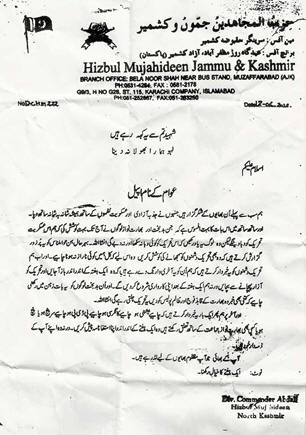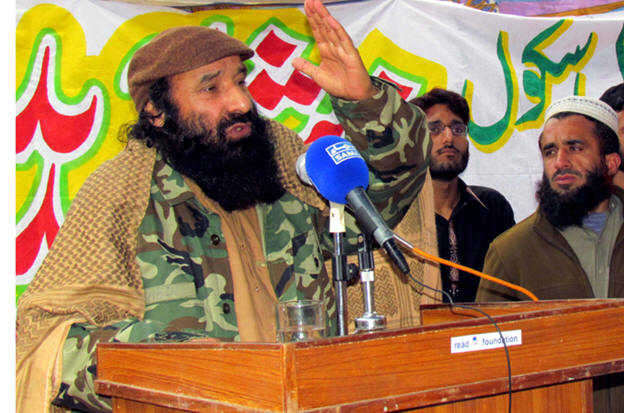|
Name of
Organization |
|
Hizb
ul-Mujahideen (HuM) |
|
Formation |
|
The outfit was
formed on September 15, 1989 at district Budgam in
Indian Administered Jammu and Kashmir
[1]. HuM is believed
to be the successor of
Ansar ul-Islam formed in the
1980s [2]. According to available information the group was
originally called Al-Badr, but the name was later
changed [3]. The outfit was formed by the unification of
approximately 12 militant groups. The group is believed
to be the militant wing
Jamaat-e Islami in Pakistan and
Kashmir [4].
|
|
Leadership |
|
Master
Ahsan Dar
A former
school teacher, Master Ahsan Dar founded the Hizb-ul
Mujahideen in 1989. After developing differences with
the leadership, Dar left the group and founded a little
known Muslim Mujahideen in 1992
[5]. He was first arrested
in December 1993
[6] and his latest arrest was in January,
2009 after which was finally released in late 2012
[7].
Syed
Salahuddin
Syed Mohammed
Yusuf Shah a.k.a Syed Salahuddin was an unsuccessful
politician in Indian Administered Jammu and Kashmir, who
had thrice contested in elections under the banner of
Jamaat-e Islami [8]. After the formation of Hizb
ul-Mujahideen, he was appointed the group’s patron in
1990 [9]. He was elevated to the rank of supreme commander
and has been involved in cleansing any opposition within
the organization and the movement within Kashmir
[10]. He is
currently also the chairman of
Muttahida Jihad Council.
[12]
Hilal
Ahmed Mir
Hilal a.k.a
Nasir ul-Islam had earlier formed Ansar ul-Islam in
1980s, which converted the movement from secular to
Islamic militancy. He was proponent of a combined
platform for Kashmiri militants. He eventually merged
his group with Hizb-ul Mujahideen in 1989. He was
however opposed to the domination of Jamaat-e Islami in
the Kashmir movement
[13]. In 1990 Hilal Ahmed Mir was
appointed as chief of Hizb-ul Mujahideen. However, due
to difference in the HuM cadres Hilal split from the
organization [14]. He formed the splinter group of
Jamiat
ul-Mujahideen in June 1991
[15] and was later killed in 1993
[16].
|
|
School of
Thought |
|
Sunni:
The Sunnis refrain from giving exalted status to any
person other than the prophets. There is also the belief
that leader or imam should be selected with consensus.
The sect is considered to be more flexible in allowing
any person to serve as a prayer leader or preacher.
Within the Sunni sect, there are four schools of
jurisprudence. These include Hanafi, Maliki, Shafi and
Hanbali schools of thought
[17].
The group has its own extremist version of the ideology
promoting the utilization of violence to achieve their
goals.
Kashmiri Nationalists:
The outfit believes in liberation of Jammu and Kashmir
from the Indian state and accession to Pakistan.
[18]
|
|
Structure of
the Organization |
|
The
organization claimed strength of 10,000 fighters in the
early years, while now it is believed to be in a few
hundreds [19]. The outfit is based in Muzaffarabad, capital
of Pakistan Administered Kashmir, headed by Syed
Salahuddin. It consists of five divisions in Indian
Administered Kashmir namely central division for
Srinagar, northern division for
Kupwara-Bandipora-Baramulla, southern division for
Anantnag and Pulwama districts, Chenab division for Doda
district and Gool in the Udhampur district and Pir
Panjal Division for the Rajouri and Poonch districts. It
has a news agency by the name of Kashmir Press
International (KPI) and women’s wing by the name of
Banat ul-Islam
[20]. Its ranks consist of mainly Kashmiri
leadership [21]. The supreme advisory council is responsible
for the decision making in the organization.
[22]
|
|
Financial Resources |
|
The outfit
acquires funding through donations and extortions from
communities in their areas of influence.
[23]
|
|
Status |
|
Proscribed by the Indian government under Section 35 of
Unlawful Activities (Prevention) Act, 1967
[24] and
Prevention of Terrorism Act, 2002
[25]. The outfit was
further banned by the European Union in 2005.
[26]
|
|
Recruitment
tools & demographics |
|
In previous
years the group has been known to have recruited from
Kashmir and Pakistan, but it is now believed that it has
also launched recruitments within India.
[27]
|
|
Ideology |
|
HuM was formed
with the objective of securing independence for the
people of Indian Administered Kashmir and accession to
Pakistan, through violence aimed at the state.
[28]
|
|
Areas of
Operation |
|
The
organization carries out activities in Indian
Administered Kashmir. The recruitment and training is
conducted in Pakistan and Indian Administered Kashmir.
The organization also carried out trainings in
Afghanistan with Hizb-e Islami (Gulbuddin Hekmatyar).
[29]
|
|
Linkages |
|
The HuM has
established links with Jamaat-e Islami, Hizb-e Islami (Gulbuddin
Hekmatyar) and United Jihad Council.
[30] |
|
Tools |
|
Print Media:
The outfit
utilizes magazines by the name of “Zarb-e Mujahid”
[31] ,
Jihad-e Kashmir
[32] and circulars
[33] to disseminate their
message. |
| |
|
Audio / Video:
There are songs
[33] and videos
[34] glorifying the activities of
the organization.
Social Media:
N/A
|
|
web site |
|
The
organization is maintaining a website to broaden its
outreach online.
http://hizbulmujahideen.webs.com/
|
|
Service
Delivery |
|
HuM undertook
relief efforts in the aftermath of October 2005
earthquake in Pakistan and Indian Administered Kashmir.
The outfit also has launched “Save the forest” campaign
in Doda, Indian Administered Kashmir.
[36] |
|
Name
Variations |
|
The group is
also known as Hizb ul-Mujahideen Pir Panjal Regiment
[37],
Al-Jihad, Party of Freedom Fighters, Party of Holy
Warriors, Tehreek-e Kuddam ud-Din and Tehrik ul-Furqaan.
[38]
|
|
Who they are
HuM has the
objective of securing independence for the people of Indian Administered
Kashmir and accession to Pakistan, through violence aimed at the state
[39]. The
organization carries out activities in Indian Administered Kashmir. The
recruitment and training is conducted in Pakistan and Indian Administered
Kashmir. The outfit is based in Muzaffarabad, capital of Pakistan
Administered Kashmir, headed by Syed Salahuddin. It consists of five
divisions in Indian Administered Kashmir namely central division for
Srinagar, northern division for Kupwara-Bandipora-Baramulla, southern
division for Anantnag and Pulwama districts, Chenab division for Doda
district and Gool in the Udhampur district and Pir Panjal Division for the
Rajouri and Poonch districts. It has a news agency by the name of Kashmir
Press International (KPI) and women’s wing by the name of Banat ul-Islam.
Its ranks consist of mainly Kashmiri leadership
[40]. The supreme advisory
council is responsible for the decision making in the organization. The
organization is also considered as the armed wing of Jamaat-e Islami
[41]. The
HuM has established links with Jamaat-e Islami, Hizb-e Islami (Gulbuddin
Hekmatyar) and United Jihad Council
[42].
History
The outfit was
formed on September 15, 1989 at district Budgam in Indian Administered Jammu
and Kashmir
[43]. HuM is believed to be the successor of Ansar ul-Islam formed in
the 1980s
[44]. According to available information the group was originally
called Al-Badr, but the name was later changed
[45]. The organization claimed
strength of 10,000 fighters in the early years, while now it is believed to
be in a few hundreds
[46]. The outfit was formed by the unification of
approximately 12 militant groups
[47]. After the formation of Hizb ul-Mujahideen,
he was appointed the group’s patron in 1990
[48]. Syed Salahuddin was elevated to
the rank of supreme commander and has been involved in cleansing any
opposition within the organization and the movement within Kashmir
[49]. The
organization became the member of United Jihad Council, consisting of
Kashmiri militant organization; in 1994
[50]. In August 2000, the Indian
government entered into talks with the group, after it offered ceasefire in
July 2000. However, the talks broke down on August 08, 2000 after the
ceasefire was withdrawn by HuM
[51]. The group has been proscribed by the Indian
government under Section 35 of Unlawful Activities (Prevention) Act, 1967
[52]
and Prevention of Terrorism Act, 2002
[53]. The outfit was further banned by the
European Union in 2005
[54].
Organization's Message
HuM has the objective of securing independence for the people of
Indian Administered Kashmir and accession to Pakistan, through violence aimed at the state
[55]. The group has its own extremist
version of Islamic Sunni ideology promoting the utilization of violence to achieve their goals
[56].
Target Audience
The
organization is believed to have considerable support in the Indian
Administered Kashmir including Doda, Rajouri, Poonch districts and
Udhampur district in Jammu
[57]. HuM concentrates its activities to acquire
support and remove opposition to its views in Indian and Pakistani
Administered Kashmir, while it is also reported to have carried out
recruitment within Pakistan and India
[58].
Tools
As per
available information the group utilizes magazines, circulars and a website
to gain outreach among the community.
• Offline
Magazines
According to available information, they also publish magazine by the name
of “Zarb-e Mujahid” which was not found online.
Circulars
The group utilizes circulars to disseminate warnings and other messages
among the community.
Download complete details of tools used by Hizb-ul-Mujahadeen
here
Splinter Groups
Jamiat ul-Mujahideen:
Hilal Ahmed Mir developed differences with Master Ahsan Dar and (chief of
Hizb ul-Mujahideen), over the growing influence of Jamaat-e Islami. He later
split from the group to form Jamiat ul-Mujahideen in June 1991. After the
death of Hilal, the group was led by by Ghulam Rasool Shah (alias General
Abdullah/Mohammad Ramzan Sofi), while other leaders included Sheikh Abdul
Basit and Mohammed Salah. The group has a hardline stance on Kashmir issue
and does not support negotiations with the Indian government. The outfit
also is believed to be collaborating and cooperating with Lashkar-e Taiba
Syed Salahuddin, Supreme Commander HuM . .
|